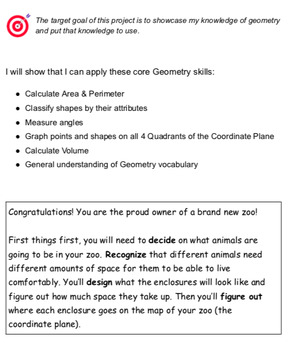Geometry Cumulative Project Zoo, PBL Project Based Learning, Math skills
Sarah Graver
11 Followers
Sarah Graver
11 Followers
Description
This is intended to be used towards the end of a unit, or in place of a unit test, that encapsulates all of the geometric concepts that have been taught.
It involves using:
- area & perimeter
- volumes
- measuring angles with a protractor
- shape attributes
- graphing ordered pairs on all 4 coordinate plane quadrants
- using Geometry vocabulary
- art
- ...and more
Total Pages
24 pages
Answer Key
N/A
Teaching Duration
N/A
Report this resource to TPT
Reported resources will be reviewed by our team. Report this resource to let us know if this resource violates TPT’s content guidelines.
Standards
to see state-specific standards (only available in the US).
CCSS4.G.A.2
Classify two-dimensional figures based on the presence or absence of parallel or perpendicular lines, or the presence or absence of angles of a specified size. Recognize right triangles as a category, and identify right triangles.
CCSS5.G.A.1
Use a pair of perpendicular number lines, called axes, to define a coordinate system, with the intersection of the lines (the origin) arranged to coincide with the 0 on each line and a given point in the plane located by using an ordered pair of numbers, called its coordinates. Understand that the first number indicates how far to travel from the origin in the direction of one axis, and the second number indicates how far to travel in the direction of the second axis, with the convention that the names of the two axes and the coordinates correspond (e.g., 𝘹-axis and 𝘹-coordinate, 𝘺-axis and 𝘺-coordinate).
CCSS5.G.A.2
Represent real world and mathematical problems by graphing points in the first quadrant of the coordinate plane, and interpret coordinate values of points in the context of the situation.
CCSS5.G.B.3
Understand that attributes belonging to a category of two-dimensional figures also belong to all subcategories of that category. For example, all rectangles have four right angles and squares are rectangles, so all squares have four right angles.
CCSS5.G.B.4
Classify two-dimensional figures in a hierarchy based on properties.





